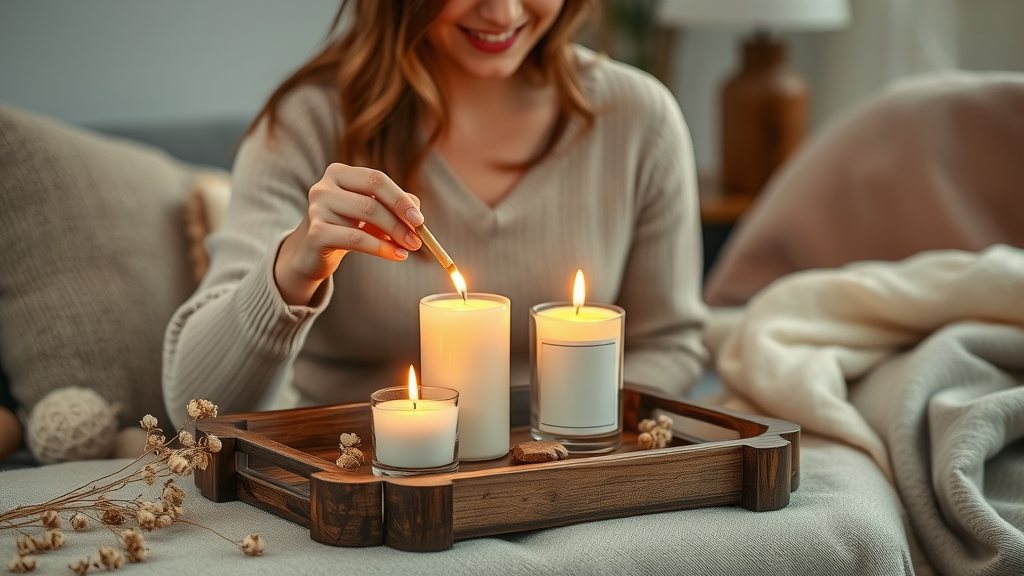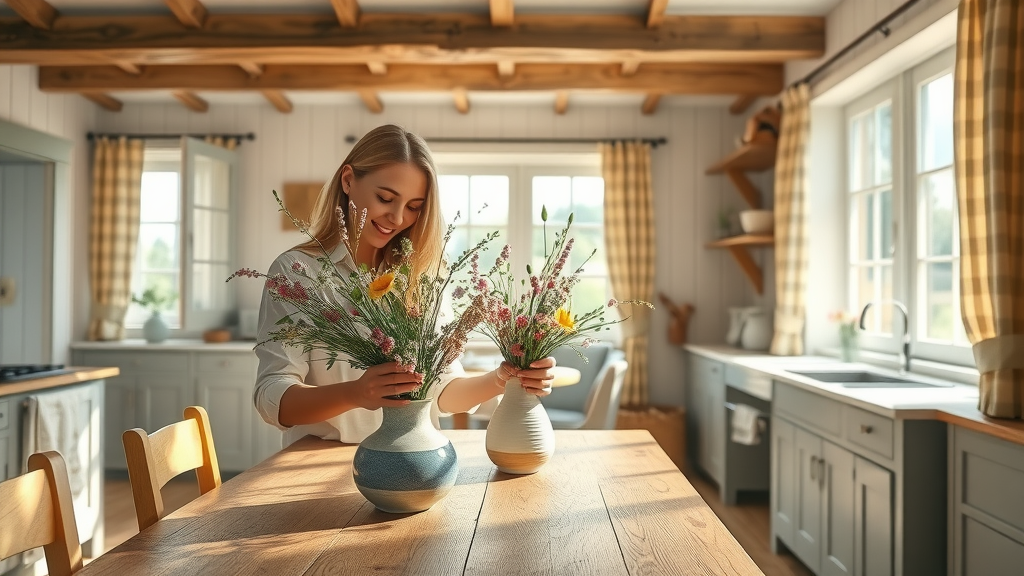Did you know that over 75% of women report feeling less stress and greater overall well-being when they live in a peaceful home environment? Harnessing the power of peacefulnesss from home-making is more than a lifestyle trend—it’s a scientifically supported way to create a more balanced, joyful, and empowered life. In this guide, you’ll discover how transforming your space can lead to real emotional and physical wellness. Whether you want a cozy country cottage vibe, a tranquil haven, or quick strategies for daily calm, your journey to a more peaceful home starts right here.
Startling Facts: The Power of Peacefulnesss from Home-Making for Women’s Wellness
For women, home isn’t just where the heart is—it’s a vital ingredient for mind and body balance. Recent studies show that creating a peaceful home lowers cortisol (the stress hormone) by as much as 30%. Women who embrace peacefulnesss from home-making report feeling safer, more focused, and more joyful in daily life. It’s not about having a “perfect” home, but about designing an environment that promotes calm, comfort, and restoration. Simple changes to your home decor, adding a candle gift set, or organizing shared family spaces can bring lasting peace at home and a substantial wellness advantage for women.
“A peaceful home is not a luxury for women—it’s essential for their holistic well-being.” – Wellness Expert
Women’s Wellness & Peacefulnesss from Home-Making: Surprising Statistics
The impact of peacefulnesss from home-making on women’s wellness is striking. Over 80% of women surveyed associate their home environment with their mental health, reporting that a peaceful home makes them feel safer and more capable in their personal and professional lives. In households where family stress runs high—due to excessive noise, environmental stressors, or clutter—women are statistically more likely to experience anxiety and disrupted sleep. On the flip side, women who take steps to cultivate peace at home (through mindful home decor, sensory candles, and daily routines) experience up to 40% higher satisfaction with their well-being, making peacefulness from home-making a cornerstone of their success.

What You’ll Learn About Peacefulnesss from Home-Making
- Effective steps to cultivate a peaceful home environment
- Top home-making strategies for stress reduction and emotional balance
- How home decor choices influence women’s sense of calm
- Insights into country cottage style for peaceful house vibes
- Ways to utilize sensory candles and candle gift sets for immediate peace at home
Understanding Peacefulnesss from Home-Making: Foundations for a Peaceful Home
True peacefulnesss from home-making begins with understanding how your surroundings influence your heart, mind, and daily actions. Creating a peaceful home goes beyond tidiness or attractive home decor: it’s about intentionally designing an environment that nurtures your needs as a woman. This means considering how light, color, scents, sounds, and even the placement of furniture support your physical and emotional wellness. Many women discover that making small, thoughtful changes—like adding calming artwork, organizing spaces, or introducing sensory candles—can transform the entire household dynamic, empowering every family member to feel safe, valued, and at ease.
Defining Peacefulnesss from Home-Making—What It Means for Modern Women
For modern women, peacefulnesss from home-making isn’t about perfection. Instead, it’s about choosing habits, home decor, and routines that reinforce feelings of peace, control, and happiness. It means arranging your home in ways that help you recharge after a busy day or create space for mindfulness even amid family stress. By focusing on what truly makes you feel calm and supported—whether that’s a minimalist tidy room or a cottage-inspired retreat—your home becomes a sanctuary for every aspect of your well-being. These intentional choices distinguish a peaceful home from a merely functional one, unlocking a level of wellness uniquely tailored to women’s needs.
Core Elements: Creating a Peaceful Home and Household
Every peaceful house starts with a few fundamental elements. Experts agree that emotional safety, an organized environment, and mindful home decor are the pillars of success. Start by carving out personalized relaxation zones—quiet corners for reading, enjoying a cup of tea, or practicing meditation. Then, tackle clutter and disorganization, both notorious contributors to family stress and anxiety. Finally, add finishing touches like soft lighting, meaningful artwork, or scented candles that speak to your senses and values. Through these components, you create a more peaceful home environment that supports your family’s wellness as well as your own.
- Emotional safety
- Organized environments
- Mindful home decor
- Personalized relaxation zones

Ways to Create Peacefulnesss from Home-Making: Practical Strategies for Women
You don’t need a total overhaul to create a more peaceful environment. Sometimes, the smallest tweaks deliver the deepest calm. Here’s how you can embrace peacefulnesss from home-making using modern, effective, and mindful strategies. Each tip draws on proven methods for reducing family stress, supporting women’s wellness, and building habits that endure. From decluttering your bedroom to experimenting with calming home decor or making the most of a beautiful candle gift set, these actionable approaches let you transform your home one peaceful moment at a time.
Declutter for Calm: Minimalism and the Peaceful House
Clutter is a hidden source of stress for many women, often elevating anxiety and interfering with relaxation. Decluttering is one of the simplest ways to create peace at home and foster a more harmonious household. Embracing minimalism doesn’t mean stripping away comfort or personality; it means making intentional choices about what belongs in your space. Start by removing items you no longer love or need, then arrange your remaining possessions with purpose. Not only will your home look more serene, but you’ll also notice improved mood and focus—especially in spaces where family stress used to peak. By transforming cluttered rooms into peaceful zones, you minimize environmental stressors and create space for positive, restorative routines every day.
Intentional Home Decor for Peace at Home
The right home decor can make you feel instantly calmer, safer, and more at ease—making it one of the most powerful ways to create a more peaceful home. Select calming color palettes in soft tones (think pale blues, gentle greens, or creamy neutrals) and bring in cozy textiles that invite relaxation, such as plush throws or natural-fiber pillows. Thoughtfully choose artwork that inspires you or evokes calming imagery. Even the arrangement of furniture can influence flow, minimizing excessive noise or visual chaos. Incorporating these mindful decor principles into your space will help create peace at home, while also serving as a foundation for forging stronger connections with family members and supporting your own wellness needs.

Creating a More Peaceful and Harmonious Environment for Women
Women seeking a peaceful house often benefit from embracing both tactile and sensory strategies to enrich their home environment. This may include curating a special spot for daily rituals, adding soft ambient lighting, integrating houseplants, or introducing soft music and subtle scents. Involve your family members by inviting them into shared routines—like evening tea or mindfulness breaks—which strengthens bonds and reduces family stress. Over time, these practices foster a consistently calm, inviting, and restorative peaceful home environment where everyone can relax, recharge, and thrive, especially you.
Creating a Peaceful Home: The Role of Sensory Candles and Candle Gift Sets
If you’re searching for quick, effective ways to create a peaceful home, look no further than sensory candles and candle gift sets. These simple yet powerful tools serve as instant mood-setters, promoting serenity and inviting you to pause and unwind. Whether you select a trio set of calming lavender, warming vanilla, or fresh citrus scents, each scented candle can influence your physical and emotional atmosphere with every flicker. Besides their benefits for you directly, a beautiful candle gift set also makes a “ready to gift” choice for empowering fellow women to cultivate peace at home. Place sensory candles in your most-used spaces—living room, bedroom, or bath—so you always have an oasis nearby.
Choosing the Right Sensory Candles for Peacefulnesss from Home-Making
When selecting sensory candles to unlock peacefulnesss from home-making, look for natural ingredients, clean-burning options (like wooden wick or soy-based), and scents that resonate with your mood goals. For evening calm, lavender and chamomile are go-tos. For focus and vibrancy, try citrus or eucalyptus. Consider candle trio sets so you can adjust the atmosphere depending on your needs—these options infuse your home with variety and encourage daily ritual. Remember, a scented candle isn’t just a decorative piece—it’s a wellness tool, helping you create peace in your home through fragrance, warmth, and the soothing glow of candlelight.

Candle Gift Sets: Elevating the Home Environment
Thoughtful candle gift sets elevate any home environment from ordinary to extraordinary. These curated selections provide a sensory ritual for unwinding after a long day or marking special moments with intention. Whether as a personal treat or a “ready to gift” idea for a friend, trio sets or bespoke candle collections are an effortless addition that can make a home feel safe and inviting. Pair with a rustic wooden tray, arrange beside reading nooks, or display in the bathroom for indulgent moments of relaxation. In this way, simple gifts become lasting forms of self-care, wellness, and harmony within every peaceful house.
Country Cottage Inspiration: Cozy and Calm Spaces
Inspired by the timeless appeal of country cottage design, many women choose this style to channel warmth and tranquility. Hallmarks of cottage decor include wooden accents, floral patterns, open shelving, and cheerful light that floods rooms with a feeling of gentle escape. To capture this cozy charm, arrange wildflowers in a vase, drape checked curtains, or incorporate vintage finds that evoke fond memories. These heartfelt touches can transform even busy family spaces into a more peaceful home environment. As you create peace at home with country cottage inspiration, you empower yourself to savor everyday joys while reducing the impact of family stress.

Tour a Peaceful Home: Transforming Spaces for Women’s Wellness
Addressing Family Stress: Creating a Peaceful Household for Women
Family stress can undermine even the most thoughtfully decorated home. To truly unlock peacefulnesss from home-making, it’s vital to recognize and address common stress triggers. Women carry a disproportionate share of responsibility for family routines, emotional labor, and household harmony. Identifying sources of tension—such as digital overload, excessive noise, lack of boundaries, or messy spaces—allows you to proactively create peace at home. Reassess how each family member uses shared areas and establish routines that minimize friction. These steps not only nurture a more peaceful house but protect your own well-being at the core.
Identifying Common Family Stress Triggers at Home
From morning chaos to digital distractions, family stress often arises from predictable patterns. Cluttered entryways, unresolved chores, or overlapping schedules can fuel anxiety for every family member. As a woman managing household wellness, take stock: Are shared spaces cluttered? Is there excessive noise from media or electronics? Do family routines lack clear communication? By identifying root causes, you can personalize your peace-building strategies and set the foundation for a calm, welcoming home. Tackle one trigger at a time—whether by implementing “quiet hours,” investing in calming home decor, or reassigning household responsibilities—so your environment truly supports, rather than hinders, everyone’s wellness.
Daily Peacefulnesss from Home-Making Habits for Female Success
Lasting peace at home isn’t the result of a single day’s effort. It comes from small, consistent habits woven into your lifestyle as a woman. Establish sacred mindfulness breaks—time just for you to reset your mood. Integrate calming rituals like lighting a scented candle before bed or playing soft music during dinner prep. Encourage open, gentle communication with each family member, so everyone feels seen and supported. Over time, these simple actions can shift the entire mood of your household, creating a peaceful home environment that’s resilient in the face of outside stressors and supports your emotional wellness every day.
- Schedule sacred mindfulness breaks
- Incorporate calming rituals into daily routines
- Encourage open, gentle communication with family
| Peacefulnesss from Home-Making Strategy | Benefits for Women |
|---|---|
| Decluttering & Organizing | Reduces anxiety, increases focus, creates emotional safety |
| Sensory Candles & Candle Gift Sets | Immediate stress relief, sets mood for relaxation, supports mindfulness |
| Mindful Home Decor | Fosters calm ambiance, inspires joy, nurtures positive routines |
| Country Cottage Style | Invokes nostalgia and warmth, encourages family bonding, promotes peace at home |
| Daily Calming Rituals | Enhances emotional resilience, strengthens relationships, supports restful sleep |
Expert Advice: Quotes on Ways to Create Peacefulnesss from Home-Making
“Creating a peaceful space is as much about the heart as the home.” – Renowned Home-Wellness Coach
Lists: Quick Ways to Create Peace and a More Peaceful Home
- Select calming color palettes
- Integrate soft lighting solutions
- Arrange furniture for positive flow
- Display meaningful, peaceful artwork
- Prepare spaces for quiet self-care
Addressing People Also Ask: Peacefulnesss from Home-Making Questions Answered
How do I create peace in my home?
Answer: Examine triggers, reorganize shared spaces, invest in sensory gifts such as candle sets, and commit to daily calming rituals.
How to create a peaceful household?
Answer: Foster harmonious routines, establish boundaries for digital devices, and design family zones for shared relaxation.
How to make a home pleasant?
Answer: Blend soft accents with natural lighting, de-clutter, and introduce fresh elements like flowers or scented candles.
How to make a home feel calm?
Answer: Curate spaces with mindful decor, diffuse soothing fragrances, and prioritize peaceful sounds or silence.

FAQ: Peacefulnesss from Home-Making for Women
-
What are the simplest first steps to achieving peacefulnesss from home-making?
Start by decluttering your main living space and adding one or two sensory candles. Focus on one room at a time, gradually minimizing visual distractions and incorporating calming decor you love. These small changes pave the way for bigger transformations. -
How much time should I dedicate to creating a peaceful home?
Even 10-15 minutes a day can make a difference. Consistency is key—devote a short daily session to tidying, setting up rituals, or updating decor, and you’ll see your peaceful home environment unfold naturally over time. -
Can peacefulnesss from home-making support my mental health as a woman?
Absolutely. A peaceful home reduces stress, enhances sleep quality, and supports emotional stability, all of which are essential for women’s mental health. Intentional routines, calming decor, and sensory touches help you reset and recharge.
Step-by-Step Tutorial: Setting Up a Peaceful Space at Home
Key Takeaways: Achieving Peacefulnesss from Home-Making as a Woman
- Your home environment shapes your wellness and success as a woman.
- You can create peace at home through intentional choices and daily habits.
- Sensory candles, country cottage inspiration, and minimalist decor revitalize peacefulnesss from home-making.
Ready to Embrace Peacefulnesss from Home-Making?
Subscribe for more strategies on how to be a successful woman in every area of your life: http://spotlightonyoursuccess.com
Transform your home, transform your life—peace starts at your doorstep.
 Add Row
Add Row  Add
Add 




Write A Comment